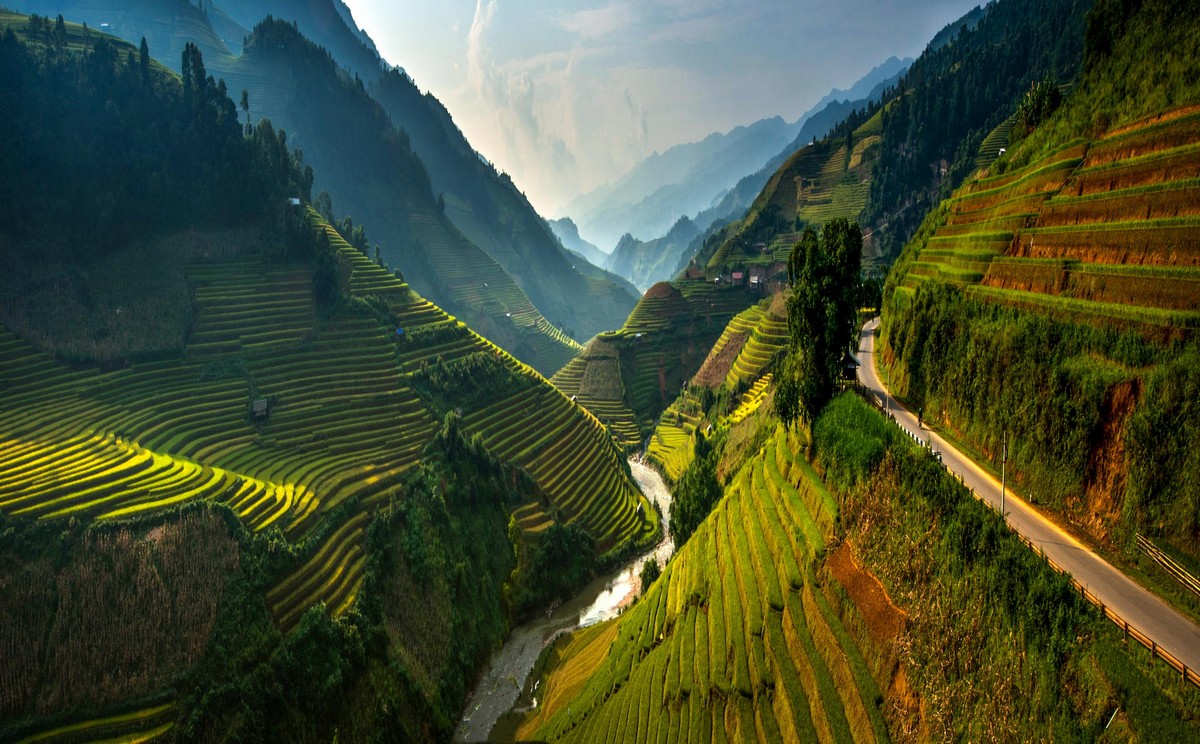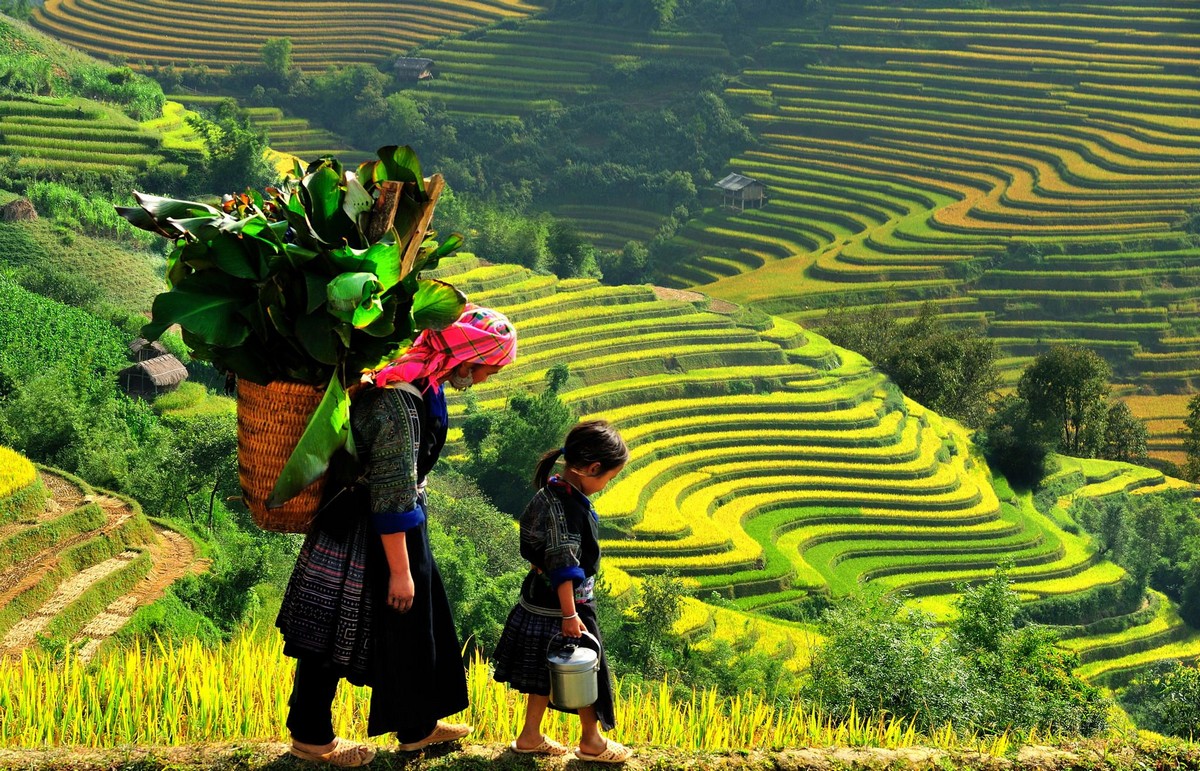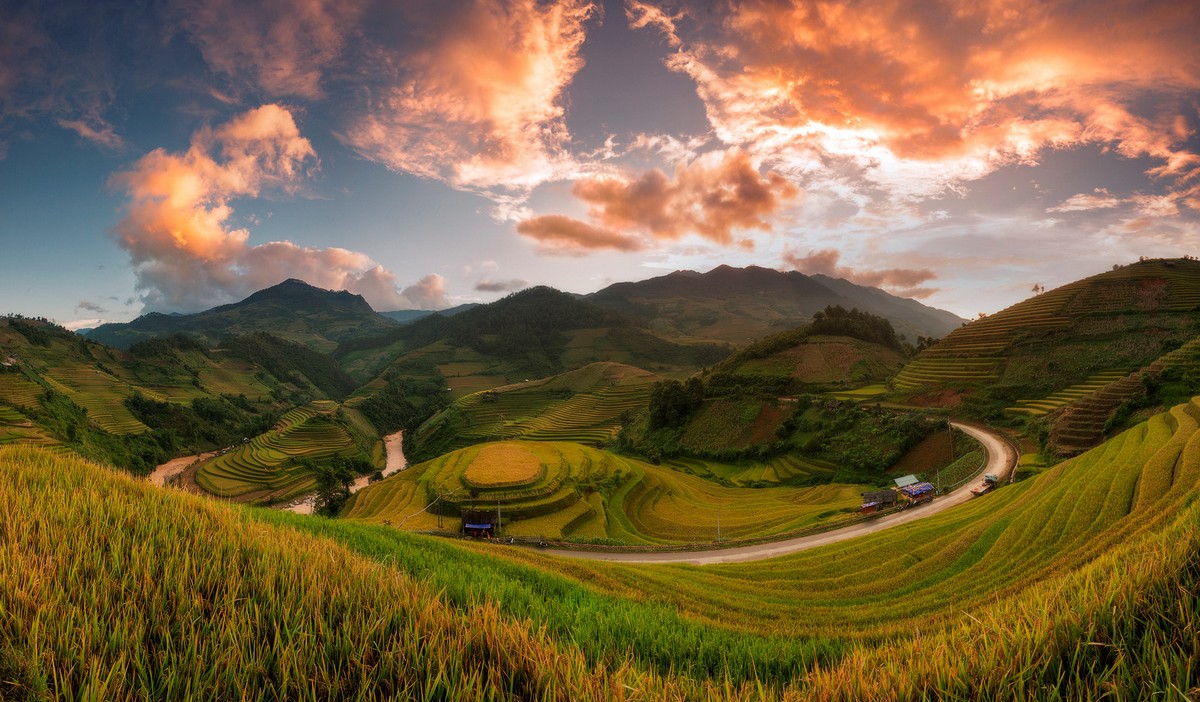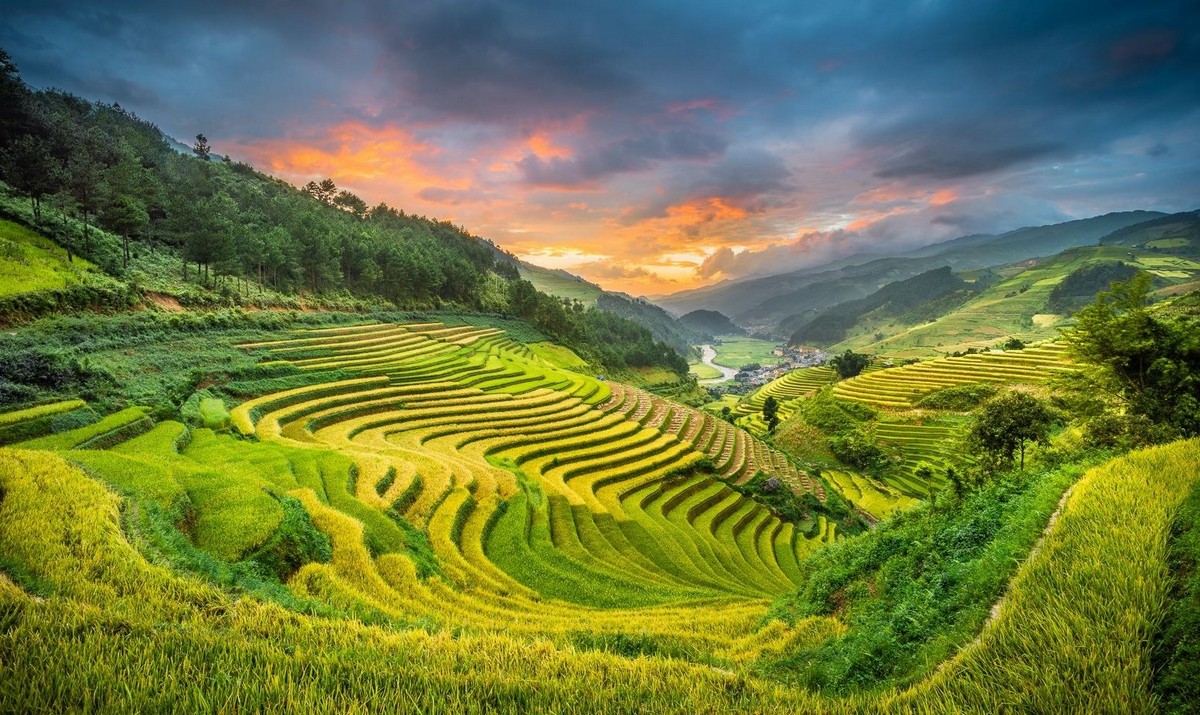Although many months have elapsed, I still remember that afternoon in the rain, the muddy motorbike, the fresh atmosphere and bright scenery of the mountain after the rain, and the pellucid smile of the little girl whose father is the owner of the house we stayed at. Every thing was so modest and peaceful.
[rpi]
WE MUST FINISH WHAT WE STARTED

When the weather in Hanoi was hot, we chose to head to Mu Cang Chai as a getaway from the hustle and bustle of the city and because we knew that this highland was in one of the two beautiful seasons of the year – the monsoon season.
At the beginning of the trip something went wrong. After booking seats on a coach that did not pass by Mu Cang Chai on its way to Lai Chau, we had two options, come back home or stop halfway to catch another coach to Mu Cang Chai. With 30 seconds of thinking, us two young ladies decided to board the coach. At 4am when the sky was still dark, in the middle of nowhere, the coach dropped us at the crossroad of Hua Bo 2 Village (Son Binh, Tam Duong, Lai Chau). We walked into a small grocery store where the light was on but the owner was asleep, we sat waiting and wondered to ourselves: “Where are we?” After more than 2 hours, we got on a coach to Mu Cang Chai at 6am, and it turned out the distance from Son Binh, Lai Chau to Mu Cang Chai was not 40km as the previous driver said to us, but 100km.
Throughout the long journey, the driver constantly looked at me with concern on his face and he handed me a plastic bag in case I got sick over 10 times. Later reflecting back on the journey, besides the beauty of Mu Cang Chai, the sound rising from our stomachs is also one of the things remaining in my mind.
When arriving in Mu Cang Chai Town, after renting a room at an inn and eating breakfast, we rented a motorbike to start our first journey: Khau Phue – Tu Le Pass. Khau Pha Pass was named by Tai Dam people and means the Horn of Heaven (the horn rising to the sky). Located at an altitude of about 1,200 metres above sea level, this is the highest of the four big passes in the Northwest. I heard the innkeeper say that in the past, Hmong people living in this area believed if they climbed to the summit of Khau Pha Pass, God would hear their prayers so when life was hard, they came here and prayed to God.
When arriving at the foot of Khau Pha Pass, the summer rain poured down heavily. The rain came with a fury and whipped our faces. Equipped with a raincoat, we continued to drive slowly. Driving around bends, the temperature dropped as we went up, although it is in the midst of the summer, the summit was obscured by thick clouds, restricting our vision. But perhaps the lucky gods were still smiling upon me, as there were very few big trucks running on the pass, sometimes there were only few Win motorbikes driven by ethnic people rushing trough the mass of raindrops.

When we arrived at the top of the pass where a rest area is located, it only sprinkled and then stopped raining and the sun threw out her first beams. Thanks to that, I could admire the beauty of Phu Gia Valley in the monsoon season. In the bright golden sunshine, the brown colour of the soil, the green of the young rice, the yellow colour of the alluvium and the sparkling water creates a magnificent multi-coloured mural amidst the vast land.
Not as magnificent as the terraces in autumn when they are covered in a golden hue and the luxuriant ripe ears of rice. Mu Cang Chai’s terraced fields in monsoon season bring a very special beauty wearing the cold, modest and pristine colours which are authentic to the North West and in some places, the terraces have the green colour of young rice full of vitality.
After feasting our eyes on the beauty of Cao Phuc Valley, we drove the motorbike to Tu Le Pass. The fragrance of the young rice and the sweetness of Tu Le rice flakes still remained at the tip of our tongues as we slowly roamed through the small trails of Thai Lim Village – home of the Thai community, located at the lowest area of land by a stream, just below Khau Pho Pass. And of course, we did not hesitate to conquer steep and winding bends to reach Lim Mong – a Hmong people’s village where nestled at the heart of freedom and pride those are at home who used to live in high mountains, where the heaven meets the earth.
WHERE EMOTIONS FLOURISH

When we got used to the feeling of excitement of driving on the mountain, we returned to La Pan Tan to search for terraces called “round tray of sticky rice on the top of the ladder to heaven”. The road to La Pan Tan was really horrible, it was flooded with rugged red soil and has many bends and slopes, on one side is the mountainside, on the other is the deep canyon. At times, the road has steep slopes like a thrilling horror game, making my heart beat against my sternum. Sometimes, the motorbike seemed to be in a vertical position, climbing slowly up the slopes amidst the untouched mountain. Sitting behind my companion on the motorbike, my face turned pale, afraid of falling of the motorbike. It was raining again and the road was muddy. Sometimes motorbikes of the indigenous people passed by; they just revved up the engine to lumber up the mountain slopes, but did not forget to give us friendly smiles. The road is really a nightmare so if you do not have the courage to conquer this difficult road yourself, then you can choose motorcycle taxis driven by indigenous people.
La Pan Tan appeared right in front of my eyes with the wonders of terraced fields looking like the “fingerprint of the land”. Looking from above, the sparkling vibrant colours spreading across the hills made the scenery even more spectacular. The green colour of the young seedlings in the field is not as beautiful as the gold when it turns ripe but it is bright, fresh and full of vitality.
“Youth is like a heavy rain. Even though you catch a cold from it, you still look forward to experiencing it once again.” And the feelings about our “reckless” journey keep my heart throbbing whenever the memories flood back. From La Pan Tan, we continued to drive along the muddy path and we planed to return to Mu Cang Chai Town. But unexpectedly, when we just got down to the foot of the pass, that catty lady called “weather” continued to coddle and it rained again. The rain became a downpour. So we were forced to nestle in a local house. The little house had its back to the highway, looking towards the mountain, with a pretty little gate.
The owner was enthusiastic and rustic. Using pigeon Vietnamese, with a little shyness, he told us many stories from the weather in the mountainous area to the colourful dresses of Hmong people. His little daughter looked at us with her round big pellucid eyes and sometimes gave us an innocent smile to welcome the guests from far away. At such a time, a melody suddenly rose in my mind “some people have a dream of wealth, some people have a dream of peace…”. For many people, perhaps the life of deprivation in this area is boring but looking at the way he smiled and told us the story about the farm, the way he hugged his dear little girl full of love, I saw the fullness and happiness in his heart.

From the experiences we had on the difficult road to Pan La Tan, our journey to explore Mu Cang Chai became easier. From Che Cu Nha to De Xu Phinh and Ba Nha Bridge, we continued to explore remote villages, drove up towering mountains, looked over sparkling terraced fields full of water in the afternoon light as the pure white clouds slowly floated in the sky. I occasionally met some groups of Hmong women walking on the precarious mountain road, some were very old, but they still carried bamboo baskets in smoke-black colour, walked agilely with hands folded in front of their chest, making them look whole and hearty. Another interesting thing about Mu Cang Chai is that you can catch friendly smiles everywhere, from small children playing on the side of the road to ethnic minority people who speak little Vietnamese. Whatever you ask, they will enthusiastically smile and answer, as if you have been their neighbour for a long time.
Mu Cang Chai has the two most beautiful seasons of the year, they are monsoon season in May and June, and the harvesting season in September and October. The monsoon season was over, but if you want to see Mu Cang Chai covered in the golden yellow of ripe rice in the sunshine of autumn, this September do not hesitate to put on a backpack and go. Besides admiring the captivating scenery when the golden yellow colour of the autumn covers the terraces in Mu Cang Chai, you can also see the spectacular annual paragliding festival themed “flying on the golden season” hosted by the People’s Committee of Yen Bai Province and the Northern Airlines Club and Vietwings Hanoi Club.
The panic clutched at my heart when I heard about the terrible flood damaging this town. After the flood, I knew they still kept smiles on their faces, the terraces will continue to turn green in the near future, but somehow deep in my mind, I am afraid that that these paradises will disappear one day. In the newspapers, it said that the Maldives may be buried beneath the tide, the Great Barrier Reef will disappear within two decades, romantic Venice will sink and the vast scale of the Amazon is reducing. Recently, Jiuzhaigou Village, Sichuan, China, which has been nicknamed “paradise on earth”, has been hit by a magnitude 7 earthquake and temporarily closed while tourist season is approaching.
I know that my steps will be more rushed, and I will have more journeys ahead, I will go with respect and a broader mind to see the spectacular.scenery of nature that may later be only visible on photographs or postcards.
W.TIPS
TRANSPORTATION
If you travel from Ho Chi Minh City, you should keep a lookout for the early tickets of Vietnam Airlines and Vietjet Air to get cheap deals. After arriving at Noi Bai airport, take a bus or taxi to central Hanoi to rest and eat. Then, from Hanoi you can choose to drive a motorbike, private car or travel by sleeper coach to Mu Cang Chai.
♦ By motorbike: From the centre of Hanoi, go straight on National Highway 32 over Trung Ha Bridge (Ba Vi), through Thanh Son District (Phu Tho), then pass by Nghia Lo Town, Tu Le Commune (Van Chan District) of Yen Bai City to De Xu Phin, when passing Khau Pa Pass, you will come to Mu Cang Chai. The travelling time is about 8 hours.
♦ By private car: You can take the Noi Bai – Lao Cai expressway to Yen Bai City and then drive to Nghia Lo. Or, you can take Noi Bai – Lao Cai expressway to Sa Pa, then go over Quy Ho Pass, Tan Uyen and Than Uyen in Lai Chau Province to Mu Cang Chai. It is best to change your routes when going back to gain more experiences.
♦ By coach: There are many high quality coach brands at My Dinh bus station for you to choose from like Hai Van (02437223588), Hung Thanh (0985694910 – 0985694901) and Thao Nguyen (0972226565 – 0942226565) or you can catch long-distance buses from Hanoi to Than Uyen, that go through Mu Cang Chai.
♦ How to travel in Mu Cang Chai: In Mu Cang Chai, you need to rent a motorbike to move more conveniently. Motorbike rental is from VND100,000 – 150,000 per day depending on the time.
ACCOMMODATION
Mu Cang Chai tourism has not developed so most of the accommodation facilities are guesthouses and homestays. You can choose to stay at Tu Le Town (Hoang Quan Guesthouse – 0216897126, Xom Vang – 02163897205, Pho Nui – 02163897115); Nghia Lo Town (Nghia Lo Hotel – 02163870106, Mien Tay Hotel – Nghia Lo – 02163870698) or in Mu Cang Chai Town (Son Ca Guesthouse – 0988981675, Suoi Mo – 0915842789, Buu Dien – 0975644965, Moon – 0912058899).
The average room rate is VND150,000 – 250,000 per room per day. During the high season, the price can fluctuate between VND 400,000 – 500,000 per room. If you choose homestays, the price per person is VND60,000 – 100.000 per person.
EAT
When you come to Yen Bai, you can enjoy local specialties such as: five-coloured sticky rice, sticky rice and Tu Le green sticky rice, Pa Ping Top baked stream fish, black square sticky rice cake, grilled chicken with clausena, stream crab and fried grasshopper.
Mu Cang Chai centre also has popular dishes such as vermicelli, noodles, rice and hot pot for people not used to ethnic dishes. Also if you like to eat fresh salmon, do not miss some of the famous restaurants on Khau Pha Pass.
CLOTHES
Weather in Mu Cang Chai is often difficult to predict and change continuously throughout the day. Therefore, you should prepare warm clothes, windbreakers and raincoats to avoid the risks of sudden rains.
If you go by motorbike, do not forget to equip yourself with standard helmets, arm and leg protectors, gloves and reflective stickers. When riding a motorbike in the rain, it is recommended to bring a raincoat, a hairdryer and a shoe cover.
SHOPPING
Assam apple, wild bamboo shoots, honey and Tu Le green sticky rice are all specialties of Mu Cang Chai and you can buy them as gifts for relatives and friends.
Thu Hoai | Wanderlust Tips

